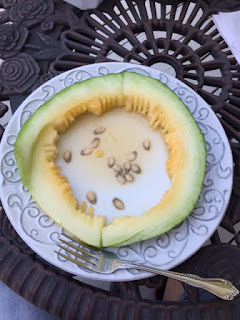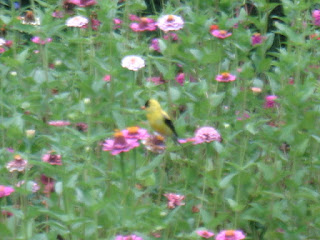Greetings Wild Indigo readers! Last week was pretty crazy so in lieu of the missing post last week my focus this week will be heavy on info with pictures as the highlight. August has arrived and with it comes some lovely flowers which have just bloomed in the Celtic Gardens. Now hard core gardeners are always keeping their eyes peeled for curious and unusual botanical additions. Most of the time road trips to Big Bloomers in Sanford are in order for such pleasantries. But for this gardener all I have to do is periodically check in down at the City Market on Saturdays to see what exotic offerings
LITFM has for sale. This week's post will focus on the recently purchased Red
Asclepias Tuberosa. That's right folks, I said RED!
Asclepias is the genus name for all milkweeds and is derived from
the ancient Greek physician Aesculapius and refers to the medicinal
properties of the roots.
Asclepias extract is an ingredient in medicines used to treat asthma, dyspepsia, and coughs. American Indians
used cooked milkweed for food and medicine. Unopened flowers, immature
seed pods, and young shoots may be boiled in several changes of salted
water. When served with butter, they resemble asparagus.
Milkweed, in particular the orange flowered species, tends to be a native local variety. Common milkweed was also called wild cotton, Virginia silk, and
silkweed. These old names elude to the many utilitarian uses people have discovered for the
fluffy contents of the seed pods. The early settlers stuffed mattresses
and pillows with it and during World Wars I and II the downy filling
went into life preservers and flight jackets. Also known as Butterfly weed and chigger plant, milkweed is a perennial in this locality and is considered to be a wildflower as well.
If you ever saw photos of the seed pods you can well understand why "weed" is part of its name for its silky hairs could carry the attached seeds for miles on a windy day. The process of pollination to grow these seeds is pretty tricky. According to the
Penn State College of Agricultural Sciences, milkweed flowers are hermaphroditic (they have male and female parts) but they require cross-pollination by insects to form seeds. Enter the pollinators into the equation. The sweet nectar of the Gods from the flowers attracts bees, wasps and flying insects. They enter the
crown of the flower and walk along the petals toward the food source.
Their feet slip between the petals into a narrow opening where pollinia are hidden. Pollinium are horseshoe shaped with a tiny pollen sack
attached to each end and a u-shaped handle in between. (kinda reminds me of a Michael Kors handbag but whatever!) The insect hooks
its leg onto the handle thereby dislodging the pollinium and carries
it to another flower. When it lands the insect again slips its feet
into the narrow opening, but this time when it pulls its leg free the
pollinium comes loose and sticks onto the stigma of the female flower
part. Viola! Pollination achieved! One to five flowers from each umbel become fertilized and produce a
seed follicle. This fleshy and pale
green pod is covered with soft-pointed bumps. The follicles grow to 5
inches long and 1½ inch (4 cm) wide, drying and turning brown when the
seeds mature in late summer and fall. Then the pod splits lengthwise,
releasing the flat brown seeds. Each seed has a tuft of silky hair
(pappus) attached and is easily carried aloft by the wind. And now, thanks to the fine people at Penn State for their information, we come full circle.
Where O Where are the dubious Monarch Butterflies? Seriously, it's been years since I've laid eyes on a single one. Years ago while visiting Maui, Monarch butterflies were strikingly plentiful, adding to the mystic of the islands. But now, at least here in Fayetteville, to me they are just a fond memory. The dwindling Monarch Butterfly population may be due in part to modern American farming practices, namely the use of glyphosate herbicides. (BTW: ordinary household Roundup Weed Killer contains this ingredient) This broad based weed killer used especially in corn fields where milkweed is a common accompaniment effectively kills weeds in the field to include the Monarch's preferred habitat, milkweed. Now as stated earlier, milkweed can make a pest of itself in a farmer's field. But said weed control has drastically cut down the habitat of these beautiful insects.
The King of the Butterfly needs a surge in plants which support their natural habitat to encourage their migration. Informative sites like
this one give great tips to help restore monarch habitation and encourage Monarch migration back to its hay day. And be sure that you don't mistake
this caterpillar for a pest! : )
Now getting back to the cautionary sides of growing common milkweed plants. When any part of the plant is broken a sticky white sap oozes from the wound. This sap can cause a red itchy rash and if it gets into the eye can cause significant cornea inflammation so its best to wear gloves during handling and pruning while being mindful to keep the gloves away from your face. If some suspected sap gets on your hands then promptly wash them with soapy water. Common milkweed (Asclepias Syriaca) contains
cardenolide which is chemical steroid and a cardiac arrester. Concentrations of this chemical vary from one milkweed species to another. But Monarchs use this chemical to their advantage for as they consume milkweed leaves this chemical builds up in their bodies and makes them toxic to predators. So if a bird ate a Monarch
butterfly or caterpillar it would throw up. How brilliant!! But considering its usefulness the Celtic Garden is quite pleased to
call this plant a staple despite its potential danger but more on that
in a minute.
So let's unveil the goods, shall we? I love these star-shaped buds and look at that gorgeous red color!
They're just starting to open up. What a treat!
The plant started from a single stem and is now branching out at the sides. This plant has a long tap root so when looking for the perfect spot be absolutely sure, for uprooting and moving it to another spot could kill the plant.
That winds up this weeks post. I hope you enjoyed reading through it and tapping into all of the provided links it as much as I enjoyed researching this post. Stay tuned for more wild and wooly Celtic Garden adventures as we begin winding up for our Fall garden while caring for Summer's harvest.
And as always, may happiness be a ray of sunshine in your mind, body and soul. ; )









